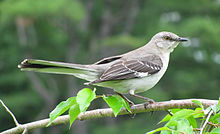
This afternoon (April 16, Easter Sunday) as we entered the dog park, Nika and Noah made a beeline for an area shaded by three large trees where squirrels usually hide out. As Noah trotted over to the first tree and sniffed at the trunk, a mockingbird swooped down, chattering madly, and nearly hit him. Then a second mockingbird did the same thing when Nika and several other dogs arrived to do the squirrel sniff test. The dogs barely noticed the birds, but we humans did.
“They’ve got a nest somewhere in here,” remarked a man sitting at the picnic table.
I watched the birds for several minutes, swooping into another area of the park where other dogs were sniffing at the trees, trying to locate squirrels. I followed Nika and Noah to the path, lined with more trees, and a woman walking her dog – a really small dog – said one of the mockingbirds had struck her dog while they were walking near the fence. “And my dog is just inches above the ground, so that gives you an idea of how low that bird had to swoop.”
I didn’t think anymore about it until we left the park and I saw the woman with the small dog watching something at a tree near the park fence. She saw me and waved me over. “The baby those mockingbirds was protecting just fell out of the tree. I tried to pick it up to put it back into the branches, but it got scared and fluttered away from me.”
I went over to the tree and the little guy was huddled on the ground. I tried to distract it while the woman cupped her hands around it gently. Suddenly, its downy wings fluttered and it sort of flew, but mostly hopped away, through an opening in the fence and into the dog park. I was moving toward it when the mockingbird swept up behind me and struck me in the back of the head.
It didn’t hurt, but it startled me and the woman and I backed off. Then the bird swooped toward the baby and chased it back through the hole in the fence so it wasn’t inside the dog park.
When we got home, I did some research on mockingbirds. The northern mockingbird, common to North America, lays an average of four eggs that hatch 11 to 14 days after incubation. After 10 to 15 days, its considered to be independent even though its ability to fly isn’t fully developed.
So this was the drama that had been unfolding at the dog park. The vigilant parents were trying to protect the little guy until it could actually fly. I thought about this as a message. I was struck by the bird, not injured in any way, but it startled me and certainly seized my attention. Mockingbirds sing joyfully. They’re communicators.
Right now, Rob and I – communicators – have four projects making the rounds, a novel and three non-fiction proposals, the number of eggs mockingbirds typically lay. If I look at the life cycle of these birds for timing, as I’ve done with these bird encounters in the past, then in 10-15 days, good news – joyful news – should arrive about one or all of these projects. Stay tuned!








I have been plentifully blessed with mocking birds, and one currently singing I call “Mozart” because he’s clearly so talented. Amazing birds. I also have 5 cats, so they are quite busy sometimes harrassing and dive bombing the cats, who take shelter under lawn chairs. Even so, the birds sit on the chairs and scream (in bird language) “Cat! Cat! Cat!” all day long, making sure that the bird population knows the whereabouts of the hated predators. My poor old Sweetpea is terrified of the birds!
Here’s hoping that incubation period of your projects are soon “fledged”!
Great story, Lauren!
Interesting information about those birds. I don’t think they are around here, but I’ll look them up. And I am sure you’ll have good news about one or all of those projects! I am definitely staying tuned. 🙂
Wen I told Megan about this, she found it interesting that the little bird wasn’t quite “ready to fly” yet.